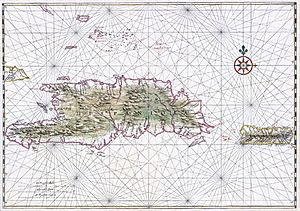Spanish reconquest of Santo Domingo facts for kids
Quick facts for kids Reconquista |
|||||||
|---|---|---|---|---|---|---|---|
| Part of the Napoleonic Wars | |||||||
 Map of Hispaniola and Puerto Rico |
|||||||
|
|||||||
| Belligerents | |||||||
| Commanders and leaders | |||||||
| Strength | |||||||
| 2,000 6 frigates |
2,600 | ||||||
The Reconquista was a war fought in Santo Domingo from November 1808 to July 1809. It was a time when people in Santo Domingo wanted to break free from French rule. This happened after Napoleon invaded Spain in 1808.
The local people, called criollos (people of Spanish descent born in the Americas), started a revolt. They wanted to bring back Spanish colonial rule. This period of Spanish rule after the Reconquista is known as España Boba.
The Fight for Santo Domingo
The main battle of the Reconquista was the Siege of Santo Domingo of 1808. This long fight lasted from November 7, 1808, to July 11, 1809. It took place in the city of Santo Domingo, which was then a Spanish colony.
A group of 1,850 soldiers from Santo Domingo and Puerto Rico led the attack. Their commander was General Juan Sánchez Ramírez. The British Navy also helped by blocking the city by sea. British Commander Hugh Lyle Carmichael led this naval blockade.
The combined forces surrounded the city for eight months. Inside, about 2,000 French Army troops defended Santo Domingo. They were led by General Joseph-David de Barquier. Finally, the French forces were captured.
How the British Helped
British Major General Hugh Lyle Carmichael played a big part in the siege. He sailed from Jamaica with several British regiments. These included the 2nd West Indian, 54th, 55th, and Royal Irish regiments. Their goal was to help Spain, who had become Britain's new ally.
Captain William Price Cumby's ships escorted Carmichael's convoy. These ships included HMS Polyphemus, Aurora, Tweed, and others. Carmichael landed at Palenque, west of Santo Domingo, on June 28. He quickly met with General Juan Sánchez Ramírez. Ramírez had been leading the siege against the French for eight months.
Even though many Spanish soldiers were sick, they pushed forward. On June 30, they captured San Carlos Church. This cut off communication between Santo Domingo and Fort San Jerónimo. It also secured a beach for the British ships to support the attack.
The French defenders were losing hope. They asked for a ceasefire, but it was refused. They asked again on July 1 as the first British troops arrived. As talks continued, Carmichael kept up the pressure. He set up large siege cannons around the city. He also gathered his forces, ready for a final assault.
French Surrender
On July 6, the French finally agreed to surrender. General de Barquier chose to surrender to the British, not the Spanish. The next day, British troops took control of the city and Fort San Jerónimo.
The French soldiers were then taken directly to Port Royal, Jamaica. No lives were lost on either side during the surrender.
See also
 In Spanish: Guerra de la Reconquista para niños
In Spanish: Guerra de la Reconquista para niños
- Dominican War of Independence
- Dominican Restoration War
- Six Years' War

